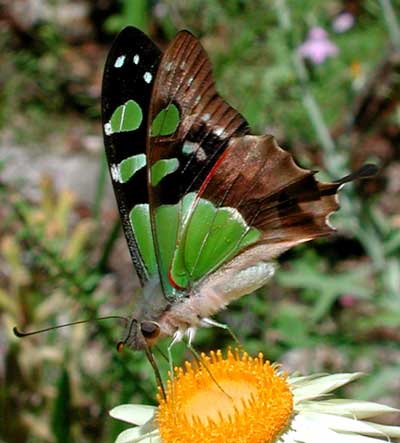![Director of National Parks [logo]](/images/dnp_90px.gif)


![Director of National Parks [logo]](/images/dnp_90px.gif) |
 |
 |
|
 Macleay Swallowtail Butterfly on a Xerochrysum sp. on the edge of the Rainforest Gully, ANBG. Photo: © Tony Woods |
In the Rainforest Gully of the Australian National Botanic Gardens in summer, you may catch glimpses of a greenish butterfly as it circles the treetops or descends to restlessly sip nectar from flowers, never stopping for long, wings in constant vibration. This exquisite insect is the Macleay Swallowtail, Graphium macleayanum. It is related to other members of the butterfly family Papilionidae such as the Orchard Butterfly, Canberra's biggest, and the magnificent blue Ulysses Swallowtail of north Queensland.
The green, hump-backed caterpillars of the Macleay Swallowtail feed at night on the leaves of a number of different trees and shrubs in the families Lauraceae, Monimiaceae, Rutaceae and Winteraceae. In the Botanic Gardens they have been observed on Cryptocarya triplinervis, and since the 'sassafras trees' Atherosperma moschatum and Doryphora sassafras, both growing of the Rainforest Gully, are recorded as caterpillar food plants in the wild, the Botanic Gardens Swallowtails may be feeding on them as well.
The Macleay Swallowtail is native to the wetter coastal and mountain parts of eastern Australia, from northern Queensland south to Victoria and Tasmania. It also occurs on Lord Howe Island and in the highlands of Papua New Guinea. Canberra used to be peripheral to the distribution of this butterfly, with only occasional sightings that were presumed to be vagrants from the coastal ranges to the east (e.g. Clyde Mountain), where it is common. With the establishment of the Botanic Gardens' Rainforest Gully containing food plants, the insect found a suitable habitat and was able to colonise it.
Interestingly, the Macleay Swallowtail also occurs naturally in the Brindabella Range to the west of Canberra, but as a distinct subspecies that extends south through the mountains of Victoria and into Tasmania. In the Brindabella Range and Snowy Mountains, the caterpillars of this subspecies are known to feed on leaves of Mountain Pepper (Tasmannia).
Kimberi R. Pullen
Ecosystem Function team
CSIRO Entomology